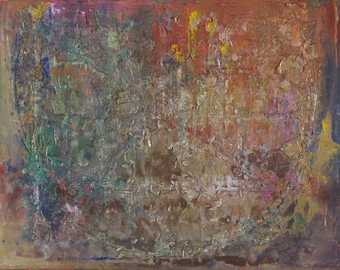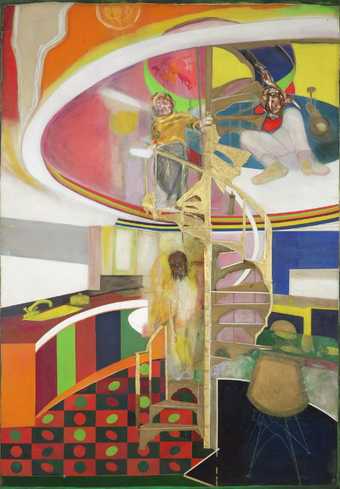
Sir Frank Bowling OBE RA
Spreadout Ron Kitaj
(1984–6)
Tate
What a mess! Or is it? Take a look at this busy painting by artist Frank Bowling. What do you see?
What if you knew this work of art wasn’t just made with paint, but with Christmas glitter, jewellery, foam, and oyster shells? And even toys! There’s even a drawing by the artist’s young son hidden underneath. Frank Bowling took all of these things, arranged them on a canvas, and then got to work smothering them in colourful paint, layer after layer.
It’s okay if you can’t see all of those things, because the artist wanted to hide them under all of that paint.
Frank Bowling did this because he was friends with the Abstract Expressionists, who thought that paint, colours, and patterns were just as important as people and other stuff we can recognise in paintings.

Sir Frank Bowling OBE RA
Mirror
(1964–6)
Tate
Bowling started painting in the 1960s in London, where he was friends with Pop artists like David Hockney.
Can you find the chair, the staircase, and the bright yellow tap? What about people – how many do you see? This painting was made when Bowling still thought people (or figures) were an important part of his paintings.
He even painted himself in it! Once at the top and once at the bottom of the stairs. At the top he’s drawn himself with lines, and at the bottom he’s messy and smudged, almost like he’s turning into paint!
The more paintings Bowling made, the more they were about colours and smudges. After moving to New York City in 1966, he became more and more interested in splashing, dripping, and spilling paint on a canvas to create all kinds of effects.
But what are those fuzzy outlines in the middle of the painting? If you know your geography, you might be able to recognise the middle one as a map of South America. The top one is an outline of his mother's shop in New Amsterdam, Guyana. The artist calls this ‘mother’s house'.
Why do you think the artist included these maps in his painting? Maps aren’t just lines we put on the globe. They can be symbols of who we are, and where we come from.
So when Frank Bowling made this painting, he wanted us to think about the power of colours. But he also wanted to share his identity with us, through symbols in a painting. “This is who I am!” it says.

